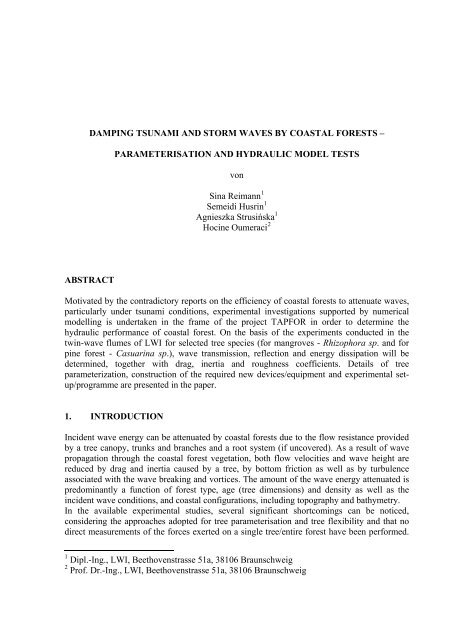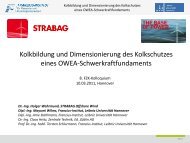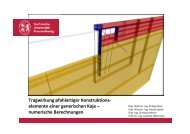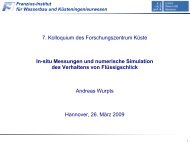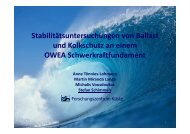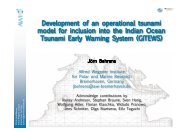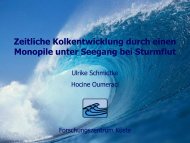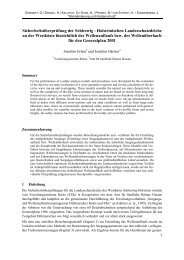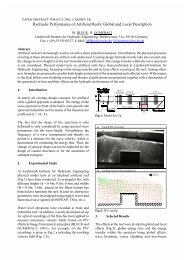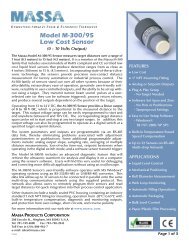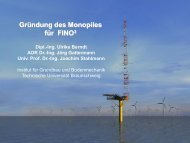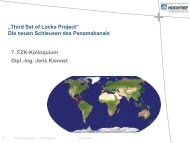DAMPING TSUNAMI AND STORM WAVES BY COASTAL ... - FZK
DAMPING TSUNAMI AND STORM WAVES BY COASTAL ... - FZK
DAMPING TSUNAMI AND STORM WAVES BY COASTAL ... - FZK
Create successful ePaper yourself
Turn your PDF publications into a flip-book with our unique Google optimized e-Paper software.
<strong>DAMPING</strong> <strong>TSUNAMI</strong> <strong>AND</strong> <strong>STORM</strong> <strong>WAVES</strong> <strong>BY</strong> <strong>COASTAL</strong> FORESTS –<br />
ABSTRACT<br />
PARAMETERISATION <strong>AND</strong> HYDRAULIC MODEL TESTS<br />
von<br />
Sina Reimann 1<br />
Semeidi Husrin 1<br />
Agnieszka Strusińska 1<br />
Hocine Oumeraci 2<br />
Motivated by the contradictory reports on the efficiency of coastal forests to attenuate waves,<br />
particularly under tsunami conditions, experimental investigations supported by numerical<br />
modelling is undertaken in the frame of the project TAPFOR in order to determine the<br />
hydraulic performance of coastal forest. On the basis of the experiments conducted in the<br />
twin-wave flumes of LWI for selected tree species (for mangroves - Rhizophora sp. and for<br />
pine forest - Casuarina sp.), wave transmission, reflection and energy dissipation will be<br />
determined, together with drag, inertia and roughness coefficients. Details of tree<br />
parameterization, construction of the required new devices/equipment and experimental setup/programme<br />
are presented in the paper.<br />
1. INTRODUCTION<br />
Incident wave energy can be attenuated by coastal forests due to the flow resistance provided<br />
by a tree canopy, trunks and branches and a root system (if uncovered). As a result of wave<br />
propagation through the coastal forest vegetation, both flow velocities and wave height are<br />
reduced by drag and inertia caused by a tree, by bottom friction as well as by turbulence<br />
associated with the wave breaking and vortices. The amount of the wave energy attenuated is<br />
predominantly a function of forest type, age (tree dimensions) and density as well as the<br />
incident wave conditions, and coastal configurations, including topography and bathymetry.<br />
In the available experimental studies, several significant shortcomings can be noticed,<br />
considering the approaches adopted for tree parameterisation and tree flexibility and that no<br />
direct measurements of the forces exerted on a single tree/entire forest have been performed.<br />
1 Dipl.-Ing., LWI, Beethovenstrasse 51a, 38106 Braunschweig<br />
2 Prof. Dr.-Ing., LWI, Beethovenstrasse 51a, 38106 Braunschweig
In view of the lack of reliable studies that would allow to understand the global and local<br />
processes leading to wave damping, laboratory investigations on the hydraulic functioning of<br />
coastal forests are being performed in the frame of the project TAPFOR (Tsunami<br />
Attenuation Performance of Coastal Forests). The project is a part of the German and<br />
Thailand cooperation on Tracing Tsunami Impacts onshore and offshore in the Andaman Sea<br />
Region (TRIAS). Using the experimental/field results, the project aims at the derivation of<br />
semi-analytical formulae and the development and of a detailed numerical model that could<br />
be employed in coastal risk management as a tool for controlled-forest growth to provide the<br />
maximum protection against storm and tsunami waves. In the paper, the achieved and current<br />
stages of the project are discussed.<br />
2. PARAMETERISATION OF <strong>COASTAL</strong> VEGETATIONS<br />
In the present study only Rhizophora sp. for mangroves and Casuarina sp. (Fig. 1) for coastal<br />
pines are considered, since both represent the most common species in coastal regions.<br />
Rhizophora sp. can be easily recognised by its airy complex root system, while Casuarina sp.<br />
has a much more simple structure. Both species represent different habitats - Rhizophora sp.<br />
can be found in estuaries, tidal flats or swampy area, whereas Casuarina sp. grows well on<br />
dry lands (sandy beaches).<br />
a) Rhizophora sp. b) Casuarina sp. c) Symbols<br />
LAI<br />
WC = 5 m<br />
WC = 12 m<br />
DBR<br />
hB : Height of buttress<br />
hC : Height of canopy<br />
hEM : Height of emerged trees<br />
hH : Total height of the tree<br />
hR : Total height of the roots<br />
hSB : Height of submerged roots<br />
hT : Height of (branchless) trunk<br />
V m /V<br />
h C = 9 m<br />
hT =<br />
4 m<br />
hR =<br />
2 m<br />
WR = 3 m<br />
Ddbh =<br />
0.2 m<br />
DR =<br />
0.08 m<br />
Ddbh =<br />
1 m<br />
h C = 27 m<br />
hT =<br />
13 m<br />
h B = 1 m<br />
AC : Area of canopy<br />
AFT : frontal area of the whole tree<br />
Ddbh : Diameter the trunk<br />
DBR : Diameter of the branches<br />
Es : Trunk stiffness<br />
LAI : Leaf Area Index<br />
Vm /V: Root volume ratio<br />
WC : Width of canopy<br />
WR : Width of Roots<br />
Fig.1: Definition of parameters for mangroves and coastal pines<br />
Efforts to parameterize coastal forest vegetation have been carried out by considering mostly<br />
the dimensions and density of the tree (Latief et al., 1999; Istiyanto et al., 2003; Imai and<br />
Matsutomi, 2005). However, none of the publications considered the importance of tree<br />
flexibility in attenuating tsunamis. Therefore, studies on the parameterisation of forest<br />
vegetation will be divided into two approaches based on the vegetation structures and material<br />
characteristics:<br />
• stiff structure assumption considering only bottom part of the tree (root system) and<br />
the trunk, adopted for mangrove forest,<br />
• flexible structure assumption considering the whole part of tree structures (root system<br />
- trunk - canopy), adopted for both mangrove and pine forest.
Due to the complexity of mangrove tree structures, first the stiff tree assumption will be<br />
adapted in the parameterisation - only roots and the trunk are to be parameterised. A real<br />
mangrove model was constructed at scale 1:20, as reference model (Model A) based on the<br />
concept of tree dimensions (Istiyanto, 2003) and root volume ratio (Mazda et al., 1997). The<br />
alternatives of the parameterised tree model (Model B and C) consist of a group of cylinders<br />
with different arrangements (staggered and tandem) were then constructed and tested in a<br />
flume with steady flows, employing different velocities and water depths. The results (total<br />
forces, head different losses, current velocities, and flow patterns) were compared to the same<br />
measurements performed for the reference model A.<br />
Cross Section<br />
Top View<br />
Reference Model A Parameterised Model B Parameterised Model C<br />
Arrangement<br />
Fig. 2: Real mangrove (Model A) and parameterised mangrove models (B and C)<br />
The results show that the parameterised models with tandem arrangement always give lower<br />
results in comparison to the models with the staggered arrangement. Therefore, further tests<br />
and analyses only consider the models with staggered arrangements. Looking at the drag<br />
coefficient (Cd) determined from force measurements, its value decreases from Cd=3.0 and<br />
converge to Cd=0.6 for all three models A, B and C. These values seem to be in a reasonable<br />
range as compared to the other previously reported values. Considering other aspects, Model<br />
B was selected for the further investigation because it has similar physical characteristics (Fig.<br />
3a) and all hydraulic properties are quantifiable to the reference model (Model A).<br />
a) b)<br />
, C d (-)<br />
, V m /V (-) , Re (-)<br />
Fig. 3: (a) Comparison of physical properties of models and field measurements (b) Drag<br />
coefficient (Cd) from experiments
Real Canopy Canopy Parameterisations<br />
www.desert-tropicals.com<br />
A<br />
Cylinder plates<br />
(porous)<br />
Cylinders Porous Cone Plates<br />
B C D E<br />
Real Tree Parameterised Pine Tree<br />
Fig. 4: Parameterised tree model for coastal pines<br />
In case of the pine forest, several alternatives were analysed by considering dimensions, age<br />
of tree, flexible behaviour, canopy density, frontal area, energy losses, numerical adaptation,<br />
and practical considerations. The parameterised model utilising a cylinder for the trunk and<br />
square plates for the canopy was selected to be investigated further in the experiments (Fig.<br />
4e).<br />
3. EXPERIMENTS ON <strong>DAMPING</strong> PERFORMANCE OF <strong>COASTAL</strong> FORESTS<br />
Parallel measurements on storm/tsunami wave attenuation by coastal forests are being<br />
performed in the twin-wave flumes of LWI, with the mangrove models placed in the 2m wide<br />
flume on a structure representing a typical beach profile. In the 1m wide flume, the beach<br />
without the forest model was constructed to investigate the influence of the forest width on<br />
the global/local processes (Fig. 5). The scale adopted in the experiments is 1:25. The beach<br />
made of plywood plates and was equipped with a constant slope (approx. 1:20) and a<br />
horizontal part of height hr=0.415m, where the tree models were placed.<br />
WAVE<br />
MAKER<br />
WAVE MAKER<br />
WAVE<br />
MAKER<br />
SWL<br />
10.0m<br />
B f =2.0m<br />
B f =1.0m<br />
WG1 WG3<br />
WG2 WG4<br />
23.64m<br />
WG5 WG7<br />
WG6 WG8<br />
FOREST<br />
h=0.415- ARRAY1<br />
ARRAY2 ARRAY3 ARRAY4<br />
0.615m<br />
BEACH<br />
FT<br />
hr =0.415m<br />
WG1 WG3<br />
WG2 WG4<br />
~1:20<br />
13.64m 8.33m<br />
8.33m<br />
WG5 WG7<br />
WG6 WG8<br />
WG1 WG3<br />
WG2 WG4<br />
~1:20<br />
~1:20<br />
WG9 WG11<br />
WG10 WG12 WG13 WG14 WG15<br />
WG9 WG11<br />
2.01m B=0.75m<br />
10.0m<br />
1.0m<br />
WG10 WG12 P1 P2<br />
FT<br />
PT1 PT2<br />
ADV1 ADV2<br />
BEACH<br />
BEACH<br />
PT1<br />
WG5<br />
WG13 WG14 WG15<br />
FOREST<br />
P1<br />
P2<br />
WG6 WG7<br />
PT2<br />
WG16 WG18<br />
WG17 WG19<br />
6.25m<br />
GLAS WINDOW<br />
WG16 WG18<br />
WG17 WG19<br />
WG8 WG10<br />
WG9 WG11<br />
Fig. 5: Experimental set-up in twin-wave flumes of LWI<br />
MEASURING DEVICES:<br />
WG – wave gauge<br />
ADV – Acoustic Doppler<br />
Velocimeter<br />
P – propeller<br />
PT – pressure transducer<br />
FT – force transducer for<br />
group of trees / entire forest<br />
FTS – force transducer for<br />
single tree
Storm waves are generated as regular and irregular waves (JONSWAP spectrum) of incident<br />
wave heights Hi=Hs,i=0.04-0.20m and incident wave periods Ti=Tp,i=1.0-6.0s at varying water<br />
depth h=0.415-0.615m. Tsunami is reproduced under the laboratory conditions as solitary<br />
waves of incident heights Hi=0.04-0.20m at the same water depth conditions as in case of the<br />
storm waves, and more realistically – as bores for whose generation a special gate mechanism<br />
is required to be constructed. Different forest widths will be examined: B=0, 0.75, 1.5, 2.25,<br />
3.0m.<br />
The instrumentations used in the tests are shown in Figs. 5 and 6. Water free surface<br />
elevation, measured by means of wave gauges, will indicate the rate of wave transmission and<br />
reflection. Flow velocities measured in front of and behind the forest using propellers and<br />
Acoustic Doppler Velocimeter (ADV) will determine, together with the forces exerted on a<br />
single tree/ group of trees, the drag and inertia coefficients.<br />
4. OUTLOOK<br />
The experiments on the attenuation performance of both mangroves and pine trees for<br />
tsunami/storm waves will be continued by implementing more detailed and systematic<br />
investigations, including Particle Image Velocimetry (PIV) technique for visualization of the<br />
flow through the forest. Procedure of bore generation will be developed after construction of<br />
the required gates in both wave flumes. On the basis of the laboratory data, semi-empirical<br />
formulae allowing to predict wave attenuation for the given forest parameters and wave<br />
conditions will be derived and implemented in a numerical model. Both experimental and<br />
numerical results will be verified by field measurements for the 2004 Indian Ocean Tsunami,<br />
which will be provided by the Thailand partners in the TRIAS project.<br />
a)<br />
b)<br />
c)<br />
Fig. 6: Model set-up and instrumentations: a) wave gauges, b) force transducer for single tree,<br />
c) force transducer for group of trees, d) beach profile<br />
d)
5. LITERATURE<br />
ISTIYANTO, D.C., UTOMO K.S., SURANTO: Pengaruh Rumpun Bakau Terhadap<br />
Perambatan Tsunami di Pantai. Seminar Mengurangi Dampak Tsunami: Kemungkinan<br />
Penerapan Hasil Riset, BPPT – JICA, 11 Maret, 2003, Yogyakarta (in Indonesian).<br />
IMAI, K., MATSUTOMI, H. (2005): Fluid force on vegetation due to the tsunami flow on<br />
sand spit. In Tsunamis: Case Studies and Recent Developments, pp. 293-304, 2005.<br />
LATIEF, H., HARADA, K., IMAMURA, F.: Experimental and Numerical Studies of the<br />
Effect of Mangrove Forest to Reduce Tsunamis. Congress of Japan Society of Civil<br />
Eng. Tohoku Area, Sendai, Japan, 1999.<br />
MAZDA, Y., WOLANSKI, E.J., KING, B.A., SASE, A., OHTSUKA, D., MAGI, M.: Drag<br />
force due to vegetation in mangrove swamps. Mangroves and Salt Marshes 1(3), pp.<br />
193-199, 1997.


